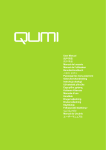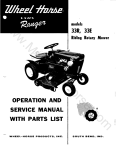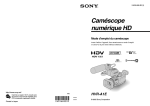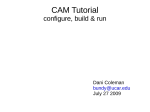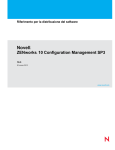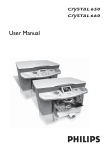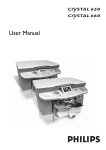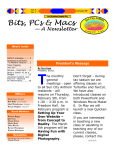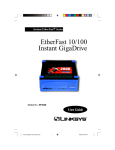Download Nikon Digital Cameras User's Manual
Transcript
1 Contents Browser Software for COOLPIX Digital Cameras Nikon View Ver.3 for Windows Overview Browsing Image Files Working with Image Files Preference Reference Manual Nikon View Reference Click to go Overview • camera drivers for COOLPIX digital cameras, which allow you to connect your camera to either the USB port or the serial port (SC-EW3 cable sold separately) of a computer and access the camera’s memory card in much the same way as you would an ordinary disk drive • a browser function that makes it possible to preview at a glance all the image files stored in your camera’s memory card, and to select items for editing, deletion, or transfer to disk Terminology used in this manual A new feature of Nikon View Ver.3 is its ability to support movie files created with the COOLPIX 990 digital camera. As you read this Reference Manual, keep in mind that most functions introduced apply to both still image files and movie files. Where this is the case, “image file(s)” will be used to refer to both types of files. Specific references to “still image(s)” or “photograph(s)”, or “movie(s)” apply only to the file type mentioned. 2 Overview • support of OLE 2.0 Drag-and-Drop, making it easy to copy images files to disk, open them in other applications, or inWelcome to Nikon View Ver.3 for Windows (below, “Nikon sert them in documents View”), browser software for the COOLPIX 990/950/800/700/ 900 series (below,“[COOLPIX digital] camera(s)”). The Nikon • simple operation featuring one-touch toolbars and menus View camera drivers and browser allow rapid, easy access to • photographs can be opened in any application that supports camera image files when the camera is connected to a comJPEG or TIFF for retouching or to be saved in another forputer. With Nikon View, the camera functions as one of your mat, allowing you to use photographs as wallpaper for your computer’s drives, making it possible to apply standard Windesktop or distribute them with electronic mail dows operations to the image files in the camera’s memory card. Once you have installed Nikon View and mastered its • movie files can be played in any application that supports simple operations, you’ll be able to distribute your digital imApple QuickTime movie format age files by disk or electronic mail, or include them in your • if you have a compact flash-memory card reader or a home page and other documents you create for business or PCMCIA card slot and card adapter, the camera’s compact personal use. flash-memory card can be browsed even when not inserted Nikon View’s principal features are listed below. in the camera The Manual Layout The contents of each chapter are outlined below. With Different Operating Systems The illustrations and explanations in this manual are for Windows 98. Display and operation may differ under Windows 2000,Windows 98,Windows 98SE,Windows NT 4.0,Windows 95, or when Active Desktop is used with Windows 95. Refer to the manuals provided with your operating system. Working Knowledge Overview This manual assumes a basic understanding of common WinDescribes Nikon View’s features and outlines the contents dows operations. If you are in doubt about the meaning of of this manual terms used here, refer to your Windows manual. Getting Started—Browsing Image Files Introduces basic techniques for browsing image files with Nikon View Working with Image Files Details the process of viewing image files, opening them in other applications, and saving them to disk Preference Discusses camera type, port and data transfer rate settings adjustment Nikon View Reference A handy reference guide to Nikon View’s menu bar and toolbar Printing this manual For ease of reference, this Reference Manual can be printed using the Print… command in the Adobe Acrobat Reader File menu. 3 Overview This manual will guide you, step-by-step, through the process of using Nikon View with your COOLPIX digital camera. For details on Nikon View installation and system requirements, refer to the Quick Start Guide. To make it easier to find the information you need, the following symbols and conventions are used: A table of contents appears on the first page of the Reference Manual. In addition, each chapter begins with an outline of the topics covered. Click on the heading to open the Reference Manual to the indicated chapter or section. Click this icon at the bottom right corner of each page for an explanation of the symbols and conventions used in this manual. Blue text indicates a link to another part of this Reference Manual. To follow the link, click the blue text. This icon signifies the need for caution when using the product. These indications are placed in sections that should be read before operation to prevent damage to the product. This icon marks notes, information that you should read before using your camera. This icon marks tips, additional information you may find helpful when using your camera. This icon marks references to other documentation or to another part of this manual. 4 Overview About This icon marks short-cuts. 5 Browsing Image Files Browsing Image Files Once you have installed the Nikon View software as described in the Quick Start Guide, Nikon View allows you to use the camera’s memory card in much the same way that you would use any other drive. This chapter describes how to browse the image files in the camera’s memory card directly from the camera, from a compact flash-memory card reader, or from disk. Browsing Image Files From Your Camera Browsing Image Files From a Card Reader Browsing Image Files on Disk Displaying Image Files as a List Browsing in the Windows Explorer Click to go Closing the window The Digital Camera window will close automatically if you do any of the following: • Turn the camera off • Remove the memory card from the camera • Disconnect the USB cable Reopening the window The Digital Camera window will re-open automatically if you do any of the following: • Turn the camera off and then on • Remove and re-insert the memory card • Disconnect and re-connect the USB cable Nikon View supports one camera, attached to a USB port or serial (COM 1–4) port. It does not support multiple connected cameras or port-extension boards. 6 Browsing Image Files: Browsing Image Files From Your Camera Automatic Operation (only with cameras which support USB connection) You can use Nikon View to browse the image files stored in If your camera is connected to a USB port as described in the your camera’s memory card and display them as thumbnails. documentation provided with your camera, and the computer Follow these steps to view image files stored in your digital is on, the Digital Camera window will open and close automatically as described below: camera’s memory card. Opening the window Connect the camera to your computer as described in the If you insert a memory card in the camera, and turn the 1 documentation provided with your camera. camera on, the Digital Camera window will open automatically to display a list of folders containing image files that have already been recorded. Proceed to step 4. Browsing Image Files From Your Camera 2 After turning on your computer, double-click the Nikon 3 Double-click the Digital Camera icon. 7 View icon in the My Computer window. Caution! The borders of the shutter-speed/aperture display in the camera’s control panel flash on and off in a “marching ants” marquee while the computer communicates with the camera. The display continues for up to sixty seconds after the transfer of data is complete. Do not disconnect the camera until the borders of the display stop flashing. (The data-transfer display varies according to your camera model.) The camera will not function as a network drive. Consequently, the Nikon View icon will not be visible to other computers. Data-transfer display (COOLPIX 990) Browsing Image Files: Browsing Image Files From Your Camera The Nikon View window will open. 4 Folders saved in the camera’s memory card are represented by a roll film icon. Folder Names When displayed in Nikon View, folders created with the camera are prefixed by a three digit folder number. Thus, the default folder, which when viewed from the camera menus has the name “NIKON” is displayed in Nikon View as “100NIKON”. Each folder can hold up to 999 image files. If this number is exceeded, the camera will create a new folder with the same name but a different prefix (e.g., “101NIKON”). When viewed on a computer, folders with the same name but a different prefix appear as separate folders. When viewed from the camera menus, however, folders with the same name appear to be the same folder, although the full folder name with prefix appears in the photo information display in playback mode. From this thumbnail view, still images can be viewed at full resolution, printed, copied or deleted. In addition, movie files can be played, copied or deleted. See the following chapter for details. The camera’s memory card is treated as “read-only” when browsing in Nikon View. Files can not be copied from other folders to the browsing window, nor can files be saved to the camera after editing in another application. The file names displayed in the browsing window can not be changed. Should you wish to change a file name, do so after copying the image file to disk. 8 Browsing Image Files: Browsing Image Files From Your Camera Double-click the folder icon. The image files in the selected folder will appear as thumbnail images. After clicking OK to close the dialog box, check to be sure that: • the camera is correctly connected to the computer • the camera’s selector dial is not set to OFF • the USB or serial cable is connected correctly as described in the documentation provided with the computer and the camera • no other hardware is connected to the selected port • the camera’s batteries are inserted correctly • the batteries are not exhausted or dead • if you are using the AC adapter (sold separately), it is properly connected For more information on: Changing Camera Type, Port and Rate Settings The default serial port data-transfer rate is 115,200 bps. If you experience communications problems, choose a lower data-transfer rate until you find one that works as described in “Changing Camera Type, Port and Rate Settings”. 9 Browsing Image Files: Browsing Image Files From Your Camera Connection error This connection error dialog box will also appear if you speciIf the computer is unable to establish connection with the cam- fied the wrong port during installation. Choose the proper era, the following dialog box will appear. camera type in the Digital Camera Settings dialog box. Browsing Image Files From a Card Reader 2 Double-click the Removable Media icon. Follow these steps to view image files stored on a flash-memory card. 1 Double-click the Nikon View icon in the My Computer window. Folders in the card are represented by roll film icons. The Nikon View window will open. Browsing Image Files: Browsing Image Files From a Card Reader If your computer has a Type II PCMCIA card drive, you can read compact flash-memory cards using a flash-memory adapter (available separately from Nikon), or by using a compact flash memory card reader. If a card containing image files captured with a COOLPIX digital camera is inserted in either device, you can browse its contents with Nikon View. 10 3 Double-click the folder icon. From this thumbnail view, still images can be viewed at full resolution, printed, copied or deleted. In addition, movie files can be played, copied or deleted. See the following chapter for details. Nikon View automatically detects the drive containing the flash-memory card. When more than two drives are mounted (PC card slot or a compact flash-memory card reader), Nikon View selects the drive containing the memory card. If you want to browse another drive, select Hard Disk in the Nikon View window, and use the Select Folder command to select the desired drive. Browsing Image Files: Browsing Image Files From a Card Reader The image files in the selected folder will appear as thumbnail images. 11 Browsing Image Files on Disk 2 Double-click the Hard Disk icon. Follow these steps to view image files on disk. 1 Double-click the Nikon View icon in the My Computer window. You can browse the folder you selected in your last session of Nikon View. The image files will appear as thumbnail images. The Nikon View window will open. Browsing Image Files: Browsing Image Files on Disk Nikon View can be used to browse image files on disk even when the camera is not connected. 12 Browsing image files in another folder… To browse image files in another folder, choose Select Folder from the View menu, or click the Select Folder button in the toolbar. If the button is hidden, enlarge the window to bring it into view. As there are no previously browsed image files when you initially install Nikon View, the Browse for Folder dialog box will appear when you double-click the Hard Disk icon for the first time. Select the folder that you want to browse, and click OK. The image files in the selected folder will appear. When the Browse for Folder dialog box appears, select the folder that you want to browse. Click the right mouse button in an empty area of the window and choose Select Folder from the right-button menu. 13 Browsing Image Files: Browsing Image Files on Disk From this thumbnail view, still images can be viewed at full resolution, printed, copied or deleted. In addition, movie files can be played, copied or deleted. See the following chapter for details. Displaying Image Files as a List The list-style display is shown below. To view the image files as thumbnail previews again, select Thumbnail View from the View menu or click the Thumbnail View button. Click the right mouse button in an empty area of the window and choose List View from the right-button menu. Depending on the resolution of your display, the right-edge tool buttons may not be visible, even when you maximize the image to fill the screen. In that case, open the Toolbars submenu on the View menu, and then clear Text Labels to change to small tool buttons without text labels. Click the right mouse button in an empty area of the window and choose Thumbnail View from the right-button menu. Browsing Image Files: Displaying Image Files as a List To view information on an image file’s date of recording, a liststyle display is available by selecting List View from the View menu or by clicking the List View button in the toolbar. If the button is hidden, enlarge the window to bring it into view. 14 15 Browsing Image Files: Browsing in the Windows Explorer Select Nikon View, from Explorer’s My Computer folder list to display the Digital Camera, Removable Media, and Hard With Nikon View installed, you can also browse image files Disk icons. saved in the camera’s memory card using Windows Explorer. Click the Start button in the taskbar and select Windows Explorer from the Programs sub-menu. Browsing in the Windows Explorer 16 Folders in the camera’s memory card can be displayed by clicking the Digital Camera icon. Browsing Image Files: Browsing in the Windows Explorer Image files in the camera’s memory card can be browsed by clicking the icon for the desired folder. You can also use these commands to browse image files when working from a card reader or disk. Operating procedures are the same as those for browsing in My Computer. 17 Working with Image Files Working with Image Files In browsing with Nikon View, you can use the same standard operations that you would with other files under Windows. This chapter describes how to preview image files, copy them to disk, and open them for editing in other applications. Selecting Thumbnails Printing Photographs Viewing Photographs Refreshing Thumbnails and Folders Playing Movies Viewing Image File Information Rotating Photograph Thumbnails Copying Image Files and Folders to Disk Deleting Image Files and Folders Opening Image Files in Another Application Click to go Inserting Images into Documents Selecting Thumbnails To select multiple thumbnails, hold down the Ctrl key on the keyboard while clicking each thumbnail in turn. Selected thumbnail Press A on the keyboard while holding down the Ctrl key, or click the right mouse button in an empty area of the window and choose Select All from the right-button menu. Working with Image Files: Selecting Thumbnails To copy, print, or delete an image file, select the desired thumbnail by clicking it once. Selected thumbnails are indicated by a To select all thumbnails, choose Select All from the Edit menu. dark gray border. 18 Opening photographs in image windows Double-click the thumbnail you wish to view. Once transfer is complete, the photograph is opened in an image window. Select the thumbnail with the right mouse button and choose Preview from the right-button menu. 19 Working with Image Files: Viewing Photographs While image data are being copied to the image window, the following indicator is displayed. Click Cancel to abort the Photographs can be viewed at full resolution in image win- operation. dows. Photographs in image windows can be rotated and zoomed in or out using the controls on the image window toolbar. Any number of image windows may be open at one time. Viewing Photographs Rotate Zoom In Click to zoom the image view in Zoom Out Click to zoom the image view out Scroll slider Scroll bar Arrow button To close an image window, click the close button ( ) at the right end of the title bar. Rotation and zoom operations performed in the image window are not reflected in the thumbnail images in the browsing window. 20 Working with Image Files: Viewing Photographs Scrolling and resizing the image window When the entire photograph does not fit in the image window, you can view the hidden portion by dragging the scroll sliders at the right and bottom of the window, or by clicking the scroll bars or arrow buttons. Alternatively, you can enlarge the winThe image view is rotated ninety degrees dow itself by dragging the window’s borders. to the left each time this button is clicked Rotating photographs and zooming photographs in and out The photograph in the image window can be rotated or zoomed in or out using the buttons in the image window toolbar. Playing Movies While movie data are transferred, the following indicator is displayed. Click Cancel to abort the operation. Playing movies with QuickTime Player Double-click the thumbnail of the movie file you wish to play. Once transfer is complete, the movie is opened in a movie window in QuickTime Player. Select the thumbnail with the right mouse button and choose Preview from the right-button menu. If QuickTime Player is not installed, a dialog box will open and ask you for the application to be used. If you don’t already have QuickTime Player installed, you can install it from the Nikon View Ver.3 CD. Working with Image Files: Playing Movies Movies can be played with QuickTime Player. In the thumbnail view of the browser window, only the first frame of a movie file will be displayed. Movie files have the extension “.MOV”. 21 Rotating Photograph Thumbnails Rotating the selected thumbnail. Working with Image Files: Rotating Photograph Thumbnails Selected photograph thumbnails in the browsing window can be rotated ninety degrees to the left by selecting Rotate Selected from the Edit menu or clicking the Rotate Selected button in the toolbar. (Movie file thumbnail can not be rotated.) 22 Select the thumbnail with the right mouse button and choose Rotate from the right-button menu. Rotations applied to thumbnails in the browsing window have no effect on the image files in the camera, or on copies of the image file that have already been saved to disk. Rotations are saved if the image file is copied to disk after having been rotated. Deleting Image Files and Folders A confirmation dialog box will appear. Follow these steps to delete selected image files. 1 Select the image files you wish to delete and choose De- 2 Click Yes to delete the selected image files. Click No to return to the browsing window without deleting the image files. lete Selected from the Edit menu, or click the Delete button in the toolbar. To delete all folders and image files which are being stored in the camera’s memory card, select the Digital Camera icon, and then choose Format from the File menu, or click on the Digital Camera icon with the right mouse button and choose Format from the right-button menu. Delete selected thumbnails by pressing the del key on the keyboard, or click thumbnails with the right mouse button and choose Delete from the right-button menu. Caution! Image files that have been protected using the camera or the Properties window can be deleted. Working with Image Files: Deleting Image Files and Folders Image files can be deleted from the camera’s memory card when no longer needed. Note that image files can not be recovered from the Recycle Bin after deletion; be sure to back up any image files you would like to keep. 23 Printing Photographs The Print dialog box will appear. Follow these steps to print selected photographs. 1 Select the photograph(s) (JPEG or TIFF format files) you wish to print and then choose Print… from the File menu, or click the Print button in the toolbar. 2 After making changes to printer settings, click OK to print the selected photographs. Print dialog box options: Printer Name Gives the name of the active printer. Click the arrow key to the right of the listed printer to bring up a list of the printer drivers currently installed on your system, allowing you to Select the thumbnail with the right mouse button and choose Print… choose a different printer. The type, location and current from the right-button menu. status of the selected printer are listed beneath this item. Working with Image Files: Printing Photographs Nikon View allows you to print selected photographs or all the photographs in the browsing window. 24 To update the thumbnails, select Refresh from the View menu or click the Refresh button in the toolbar. Click the right mouse button in an empty area of the window and choose Refresh from the right-button menu. Caution! Do not disconnect the camera until the borders of the data-transfer display stop flashing. (The data transfer display varies according to your camera model.) 26 Working with Image Files: Refreshing Thumbnails and Folders The image files in the selected source (the camera if Digital Camera is selected, a compact flash-memory card reader if Nikon View does not immediately recognize changes made to Removable Media is selected, or a specified folder on a disk the memory card from the camera. If you add, copy or delete if Hard Disk is selected) will be read, and thumbnail previews image files from a folder, or add or delete folders from the displayed in the window. memory card using the camera controls, you must refresh the thumbnails and folders for Nikon View to recognize those You can select Refresh from the View menu, while the folders are displayed. changes. Refreshing Thumbnails and Folders 27 Viewing Image File Information The General panel gives the file name, file size, capture date, and dimensions of the selected image file. Protected and Hidden attributes set in the camera’s playback mode can be The Properties dialog box is displayed. The Properties dialog changed using the Attribute check boxes. The Photo panel box contains three panels, General, Photo and Extra. You can contains information on camera settings such as image quality switch between three panels by clicking the tabs at the top of and metering mode at the time the photograph was taken. the dialog box. The Extra panel contains camera control settings information such as exposure deviation, sensitivity and tone curves. Select a thumbnail with the right mouse button and choose Properties from the right-button menu. Click OK to accept any changes to image file attributes and close the Properties dialog box. Click Cancel to close the dialog box without changing the attributes. Working with Image Files: Viewing Image File Information Information on selected image files can be viewed. After choosing a thumbnail, select Properties from the File menu or click the Properties button in the toolbar. Copying Image Files and Folders to Disk Copying an image file Copying image files and folders using a drag-anddrop operation Select the image files or folders you wish to copy by clicking their thumbnails or icons (to select multiple image files or folders, hold down the Ctrl key on the keyboard while clicking each), then drag the thumbnail or icons to the destination folder and release the mouse button. Copying a folder All image files captured with the camera are assigned file names of the form “DSCN_nnnn.xyz” where “nnnn” is a four-digit file number and “xyz” is a three-letter extension (JPG,TIF, MOV). Similarly, all image files saved in folders in the camera’s memory card are assigned file names of the same type. To prevent image files already copied to disk from being overwritten, change the filename after copying an image file, or create a new folder for each folder on the camera. Working with Image Files: Copying Image Files and Folders to Disk Image files and folders can be copied to disk by using a dragand-drop or copy-and-paste operation. Before copying image files or folders to disk, locate or create a destination folder. 28 Browsing window 29 Working with Image Files: Copying Image Files and Folders to Disk The progress indicator will be displayed while the items are Copying image files and folders using a copy-andcopied to disk. Click Cancel to abort the operation. paste operation Follow these steps to copy image files and folders to disk using Once all items have been copied to disk, the progress indicaa copy-and-paste operation. tor will disappear. 1 Select the image files or folders you wish to copy by clicking their thumbnails or icons (to select multiple items, hold down the Ctrl key on the keyboard while clicking each thumbnail or icon), then select Copy from the Edit menu. Digital Camera window 2 Open the destination folder and select Paste from the 30 folder’s Edit menu. The selected items will be copied to the destination folder. Once all image files or folders have been copied, the progress When copying a thumbnail to disk, if an image file with the same filename indicator will disappear. has previously been copied, you will be asked whether you wish to replace Press C while holding down the Ctrl key on the keyboard, or click a thumbnail with the right mouse button and choose Copy from the right-button menu. the existing file. If you select No, a temporary file containing the image file data is created in the Windows temporary folder (path Windows folder\Temp\Camexp\Transfer). Then, when you copy files with redundant names to disk, they are saved under names created by adding a number in brackets ([1], [2], [3], […]) to the filename. This prevents users from accidentally overwriting image files on the computer. If you use this operation repeatedly, however, you will fill the temporary file. To clear disk space, you may wish to delete the contents of this temporary folder periodically—the “Windows folder” is the folder to which Windows has been installed. Working with Image Files: Copying Image Files and Folders to Disk The progress indicator will be displayed while the items are copied to the clipboard. Click Cancel to abort the operation. 2 Open the destination folder and select Paste from the folder’s Edit menu. 1 Select the Digital Camera icon by clicking its icon, then select Copy from the Edit menu. The progress indicator will be displayed while the items are transferred. Click Cancel to abort the operation. Press C while holding down the Ctrl key on the keyboard, or click a thumbnail with the right mouse button and choose Copy from the right-button menu. 31 Working with Image Files: Copying Image Files and Folders to Disk Copying all contents to disk Follow these steps to copy the entire contents of the camera’s memory card to disk from the Nikon View window. Use the same process to copy the entire contents of the The progress indicator will be displayed while the items are memory card when using a card reader. The complete Hard copied to the clipboard. Click Cancel to abort the operation. Disk folder can be copied in the same manner. Once the contents of the memory card have been copied, the progress indicator will disappear. The Digital Camera folder is located in the destination folder and contains the complete contents of the memory card. Use the same process to copy the entire contents of the memory card when using a card reader. The complete Hard Disk folder can be copied in the same manner. 32 Working with Image Files: Copying Image Files and Folders to Disk Once the contents of the memory card have been copied, You can also copy the entire contents of the camera’s memory the progress indicator will disappear. The Digital Camera card using a drag-and-drop operation. folder is located in the destination folder and contains the complete contents of the memory card. Opening Image Files in Another Application The image files will be opened in the host application. Opening image files by drag-and-drop Image files that have been selected in the browsing window can be opened in another application by dragging the thumbnails over an open application window and releasing the mouse button. Use the host application’s Save As… command to save the image files in the appropriate folder. After opening image files captured with the camera in another application, a temporary file containing the image file data is created in the Windows temporary folder (path (Windows folder)\Temp\Camexp\Transfer). As repeated use of this operation will fill the temporary file, you may wish to delete the contents periodically to clear disk space. If you save the open image file using the Save command, it is saved in the temporary folder. Use the Save As… command to save the image file in the appropriate folder—the “Windows folder” is the folder to which Windows has been installed. Working with Image Files: Opening Image Files in Another Application You can open the photographs recorded with your coolpix camera in any application that supports JPEG (“.JPG”) or TIFF (“.TIF”) formats. Photographs can be opened directly from the application or by using a drag-and-drop operation. You can use the same operations to play movies in applications that support the QuickTime movie (“.MOV”) format. 33 3 Double-click the icon of the source of the desired image file. 1 You can open image files in another application by selecting the open command from the host application’s File menu. 2 In the host application’s Open dialog box, select NikonView from the drives listed under My Computer and click Open. If you chose Digital Camera, or Removable Media, more folders from the memory card are displayed. Hard Disk displays a Select Folder dialog box. The Digital Camera, Removable Media, and Hard Disk icons are displayed. 34 Working with Image Files: Opening Image Files in Another Application Opening image files from other applications Follow these steps to open image files using the host applications’ open dialog. 4 Select a folder. The dialog box shown above is the standard Windows Open dialog box for 32-bit applications. The contents of the dialog box may vary depending on the host application. The selected image file will be opened in a window within the host application. Use the Save As… command to save the image file in the appropriate folder. 35 Working with Image Files: Opening Image Files in Another Application Thumbnail previews of the image files in the selected folder will be displayed (to change to a list display, right-click in an empty area by the thumbnails, and select List View from the menu). 5 Select the thumbnail you wish to open and click Open. Inserting Images into Documents Inserting images using a drag-and-drop operation Drag the image file you wish to insert over an open document window in another application. 36 Working with Image Files: Inserting Images into Documents Nikon View supports OLE 2.0, which allows you to insert photographs taken with the COOLPIX digital cameras into documents created by any OLE 2.0 application that supports the JPEG (“.JPG”) or TIFF (“.TIF”) image format. Photographs can be inserted in documents directly using drag-and-drop or copyand-paste operations, or they can be embedded using the insert object command. You can use the same operations to insert movies taken with COOLPIX digital cameras in OLE 2.0 applications that support the QuickTime movie (“.MOV”) format. If the host application supports OLE 2.0, the image file will be inserted in the document as shown below. Follow these steps to insert images using the insert object command. 1 In the insert object dialog box, choose Create from File, and then click Browse…. Next, open the host application and display the document window into which you wish to insert the image file. Paste the image file into the document by positioning the cursor, and selecting Paste from the host application’s Edit menu. 37 Working with Image Files: Inserting Images into Documents Inserting images using a copy-and-paste operation Inserting images using the insert object command In the browsing window, select the image file you wish to in- In applications that support OLE 2.0, image files can be insert and select Copy from the Edit menu. serted in documents using the host application’s insert object command. 2 In the Browse dialog box, select NikonView from the drives 3 Double-click the icon of the source of the desired image file. If you chose Digital Camera, or Removable Media, more The Digital Camera, Removable Media, and Hard Disk folders from the memory card are displayed. Hard Disk disicons are displayed. plays a Select Folder dialog box. Working with Image Files: Inserting Images into Documents listed under My Computer in the Look in pop-up menu, and then click Insert. 38 4 Select a folder. 5 Select the image file you wish to insert and click the Insert button to return to the insert object dialog. Click OK to insert the selected image file in the document. Working with Image Files: Inserting Images into Documents Thumbnail previews of the image files in the selected folder will be displayed (to change the list display, right-click in an empty area next to the thumbnails, and select List View from the menu). 39 40 Preference Preference This chapter covers camera type, connection port and data transfer rate settings adjustment. Changing Camera Type, Port and Rate Settings Click to go The following Digital Camera Settings dialog box will be displayed. The camera used with Nikon View, the connection port, and the data transfer rate (port speed) can be changed after installation. Follow these steps to change settings. 1 In the NikonView window, select Settings… from the View menu, or click the Settings button in the toolbar. 2 Make the desired settings changes and click OK. Digital Camera Settings dialog box options: Camera The name of the camera currently connected is displayed. If you have installed Nikon View DX, you can also select the Nikon D1 digital camera. For more information, see the Nikon View DX Reference Manual. Choose Nikon CoolPix for all models of COOLPIX digital camera. 41 Preference: Changing Camera Type, Port and Rate Settings Changing Camera Type, Port and Rate Settings If you consistently connect your camera to just one serial port, select the appropriate port number, rather than AUTO, to speed processing. 42 Preference: Changing Camera Type, Port and Rate Settings Remote Connection Speed Type If Serial is selected as the port type, clicking the arrow Options available in the Type option vary depending on the button to the right of this field displays a list of supported camera connected. If you’ve selected Nikon CoolPix, you speeds (data-transfer rates). This text box is disabled while can choose from Serial or USB (though USB is a selectUSB is selected as the port type. able option, it is only functional when the COOLPIX 990 is OK connected to your computer’s USB port). If you've selected Accepts any changes to port settings and closes the Digital Nikon D1, the Remote Connection Type indicator will read Camera Settings dialog box. 1394 (IEEE 1394 interface). Cancel Port Closes the Digital Camera Settings dialog box without changIf Serial (SC-EW3 cable sold separately) is selected as the ing port settings. port type, clicking the arrow button to the right of this text box displays a list of supported ports. Select the port to which the camera is connected from among AUTO, COM1, COM2, COM3, and COM4. If you choose AUTO, the computer automatically detects the port to which the camera is connected. This text box is disabled while USB is selected as the port type. 43 Nikon View Reference Nikon View Reference This chapter provides a brief reference guide to Nikon View’s menu bar and toolbar. Refer to this guide when you want to know the meaning of a command or button. The Menu Bar The Toolbar The Right-Button Menus Click to go The Menu Bar Properties Displays the properties for the selected image file in the Properties dialog box. You can also choose this command by clicking the Properties button in the toolbar. Menu bar Format Initializes the camera’s memory card. Work Offline Allows you to perform work while you are offline. The File Menu Browsing window Nikon View window This command can only be used in the Nikon View window. These commands can only be used in the browsing window. Close Closes the Nikon View window, terminating your Nikon View session. You can also exit the program by clicking the close button ( ) at the right end of the title bar. 44 Nikon View Reference:The Menu Bar When you browse image files in Nikon View, Nikon View commands are added to the standard Windows menu commands. The commands available in each menu are outlined below. Print… Allows you to print the selected photograph(s) to a printer that you specify. You can also choose this command by clicking the Print button in the toolbar. The Edit Menu Browsing window Digital Camera window Paste This command is unavailable from Nikon View. Rotate Selected Rotates selected image file(s) ninety degrees, counterclockwise. You can also choose this command by clicking the Rotate Selected button in the toolbar. Delete Selected/Delete The selected image file or folder is deleted from the source currently being browsed. You can also access this command to delete the selected image file(s) by clicking the Delete button in the toolbar. 45 Nikon View Reference:The Menu Bar Copy Copies the selected image file or folder to the clipboard. The image file can then be pasted into another folder or application using the Windows paste command. Select All Selects all image files in the browsing window for copying, printing or deletion. Browsing window Nikon View window This command can only be used when browsing a hard disk. Toolbar Choose this command to determine the type of toolbar that will be displayed. Status Bar Choose this command to display the status bar at the bottom of the Nikon View window. Explorer Bar Choose this command to determine the type of Explorer bar that will be displayed. Refresh Updates the image files in the browsing window. You can also choose this command by clicking the Refresh button in the toolbar, or selecting it from the View menu, while the folders are displayed. Select Folder Displays the Browse for Folder dialog box, allowing you to select the folder containing the image files you want to browse. You can also choose this command by clicking the Select Folder button in the toolbar. This command may only be used when browsing image files in the Hard Disk window. Settings… Displays the Digital Camera Settings dialog box, where you can make changes to port settings. You can also choose this command by clicking the Settings button in the toolbar. This command may only be used in the Nikon View window. Thumbnail View Displays the image files as thumbnails. You can also choose this command by clicking the Thumbnail View button in the toolbar. List View Displays the image files as a simple list, without thumbnails. You can also choose this command by clicking the List View button in the toolbar. 46 Nikon View Reference:The Menu Bar The View Menu Commands available in the View menu vary depending on the active window. The Favorites Menu A standard Windows menu command. Refer to your Windows manual for details. The Help Menu About Windows 98 Displays Windows 98 version information. About NikonView Opens the Nikon View splash window, which gives copyright information for the program. 47 Nikon View Reference:The Menu Bar The Go Menu A standard Windows menu command. Refer to your Windows manual for details. 48 The Toolbar Toolbar Enlarge the window in order to view all of the command buttons in the toolbar. When you locate the cursor on the window frame, it changes into a bi-directional arrow. Drag this arrow to enlarge the window. Depending on the resolution of your display, the right-edge tool buttons may not be visible, even when you maximize the image to fill the screen. In that case, open the Toolbars submenu on the View menu, and then clear Text Labels to change to small tool buttons without text labels. (To view a button’s label, place the mouse pointer on the button, and wait for a few seconds. A label will pop up.) Nikon View Reference:The Toolbar The buttons in the toolbar allow you to manage image files in the browsing window and perform various operations. The commands accessible from the toolbar are outlined below. Function Updates the image files in the window. Function Returns to the previous window. Proceeds to the next window. Opens the folder one level up in the file hierarchy (in the case of the Nikon View folder, the My Computer folder). Rotates the selected image file(s) 90º counter-clockwise. Deletes the selected image file(s). Clicking this button brings up the Confirm Image Delete dialog box, allowing you to permanently remove the selected image files from the open media. Brings up the Print dialog box, allowing you to print selected image file(s) to a printer of your choice. 49 Displays the Browse for Folder dialog box, allowing you to select the folder containing the image files you want to browse. This command may only be used when browsing image files in the Hard Disk window. Displays the Digital Camera Settings dialog box, where you can change camera type, connection port and transfer rate settings. This button may only be used in the Nikon View window. Displays the Properties dialog for the selected image file(s). Displays image files as thumbnails. Displays image files as a simple list, without thumbnails. Nikon View Reference:The Toolbar Button Button The Right-Button Menus Clicking the right mouse button in an empty part of the window displays the menu shown below. Click a thumbnail with the right mouse button to select the image file and display a menu of command shortcuts. These menus allow quick access to the commands in the menu bar and toolbar. Similarly, you can use these right-button menus with the open dialog and the browse dialog when browsing the Nikon View window from another application. (Only, however, in the standard Windows dialog box for a 32bit application.) You can use the Select Folder command when browsing image files in the Hard Disk window. NikonViewReference:TheRight-ButtonMenus You can use right-button menu commands to perform various operations such as Preview, Copy, List View, and so on. 50 Right-clicking the Digital Camera icon in the Nikon View window displays the menu shown below. Nikon View Reference:The Right-Button Menus Right-clicking a folder icon in the Digital Camera window displays the menu shown below. 51



















































